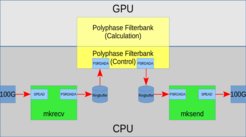Protocols and High Speed Data Interfaces
The demand of observing at higher time resolution, broader frequency coverage, or even at higher dynamic is not only limited by the receiver hardware it is also limited by the network capabilities and the ability to digest the produced data rates of the receivers.

Various protocols are used by the DSP to do the housekeeping and the data transmission and are in parts implemented as hardware or software solutions. Currently the supported protocols include: Address Resolution Protocol (ARP), Internet Control Message Protocols (IP/ICMP), Dynamic Host Configuration Protocols (IP/UDP/DHCP), Internet Group Management Protocol (IP/IGMP), and User Datagram Protocol (IP/UDP/SPEAD).
For high speed data transport, a specialized data send and receive process (mksend, mkrecv) has been developed within the SPEAD protocol. In order to evaluate the performance of this high speed data interface a test system was build, including the packetizer system that can produce data rates of the order of 40 to 100 Gbit/s, two NUMA nodes (Intel Xeon CPU E5-2630 v4), each equipped with one graphics card (NVIDIA GP102 [TITAN X]) and one network card (Mellanox Technologies MT27800 Family [ConnectX-5]).
For a MeerKAT setup (40 Gbit/s interface) it is possible to receive the original samples or the results from external polyphase filter banks, called F-Engines (> 36 Gbit/s). For the Effelsberg-Direct-Digitization setup, it is possible to receive and process the samples at up to 6 GS/s (72 Gbit/s at 12-bits per sample).
